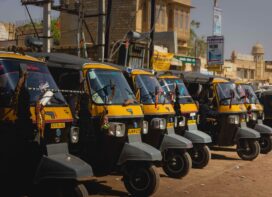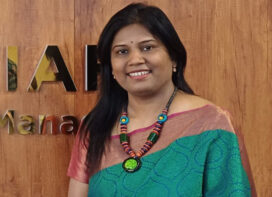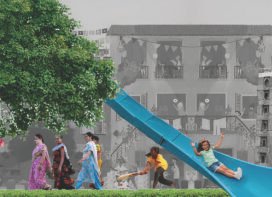
Prasanna Ganesh
Prasanna Ganesh, Executive Vice President, Toyota Daihatsu Engineering & Manufacturing, and Director, Toyota Mobility Foundation (TMF) talks to TrafficInfraTech about the Station Access and Mobility Programme, a national platform for integrated urban transport in the country and the future of mobility in India. The Foundation incubates and tests innovative solutions with entrepreneurs and initiates government level discussions and policies.
TMF has been facilitating projects around the world: Revitalizing traditional mobility, personal mobility and designing inclusive mobility. How is India’s mobility ecosystem different from that of USA, South America, Vietnam, Germany, Brazil or even Japan?
The Toyota Mobility Foundation has a mission to “Enable More People to go More Places”, which is another way of saying that we aim to deliver “Mobility for All,” by tackling ‘mobility-driven’ issues through ‘human-centric’ solutions.
Globally, since there are various problems that are mobility-related, and since we have to prioritize our resources while gaining knowledge and professional expertise, we have focused on a “portfolio” of issues for emerging economies, which is to ease congestion. In more mature markets, where there is a good balance of private and public mobility, we have tried to focus on energy-related solutions (such as exploring Hydrogen as an alternate fuel) or mobility solutions for aging or differently abled societies.
India’s issues are similar to those we have seen in other emerging markets in terms of congestion. Here, we often witness economic growth spurring rapid urbanization, resulting in a situation where infrastructure and mobility systems do not keep pace with the growth of the population. This leads to inefficient mismatches of demand and supply of mobility and inequalities in access to reliable mobility options.
Naturally, even within this broad premise, in each city in India there are unique conditions related to land use, economic development, available transport, weather, people’s behavior, policies, amongst other determining factors, that require specifically adapted solutions to ensure maximum benefits.

You have already participated in STAMP Projects in five cities across India. Two more are being initiated. What are the challenges faced?
Within the broad portfolio of tackling congestion, TMF recognized that the Government of India (and the governments of various States) was expending a great deal of resources on developing metro systems as a critical solution for the mobility needs of cities across the country.
While there are some that question the value of the investment, we believe that metro systems are a solution at scale that can work for a country like India with its sizeable population and congested land mass. Metro systems are already operational in a dozen cities and plans for more cities are underway. We believe that we can support the central and state governments in the best possible way by facilitating smart and efficient first and last mile mobility, and integrating the metro as a part of the larger transport fabric in cities through true multi-modal mobility.
TMF and WRI India Ross Center, our local implementation partner in India, designed the Station Access and Mobility Program (or STAMP), to select the best possible entrepreneurs and stakeholders, who could deliver first- and last-mile connectivity to metro stations. STAMP consists of four elements – (a) research and data gathering, (b) capacity building of stakeholders, (c) challenge contest/ partner selection, (d) incubation and test-bed implementation with key stakeholders.
We launched STAMP in Bengaluru in 2016 and selected three excellent solutions, ranging from last-mile services to passenger information systems. These innovators were all given funding and a platform to demonstrate their solutions, and the reaction and success of the pilot resulted in multiple requests to expand the program.
We recognized the first-mile mobility in India needed a more holistic approach, focusing on a commuter’s experience from one’s house to their end destination, which includes considerations such as data usage, information access, payment flow mechanisms and, mobility and infrastructure solutions.
We also recognized that different city archetypes (or catchment areas) required different solutions (e.g., residential area vs. industrial area vs. commercial area). This resulted in our decision to expand STAMP to six more cities (7 cities in total) with a slightly different focus of the commuter journey in each.
Having expanded from Bengaluru to Hyderabad, Kochi, Mumbai and now Pune, we have gathered various learnings through practically implementing carefully chosen solutions on the ground, with real commuters giving us true-life proof points and validation of what works and what needs to be improved for their journeys.
In each of the cities, we have worked hard to integrate our actions with key stakeholders including the urban planning authorities in the Government, metro agencies, other public transport agencies, citizen groups, private entrepreneurs and urban planners.
Though there have been some operational challenges faced, especially with the onset of COVID-19 and the inability to implement some of our solutions for extensive periods of time, generally we have received strong support from all stakeholders, who seem to share our desire to solve mobility issues for commuters.
What is your take on balancing commuter experience with affordability when developing integrated transit systems in India?
The objective of transit systems is to ensure that mobility needs of commuters are met safely and satisfactorily, and if so, result in improving ridership for their services. Affordability is one of the most important aspects of commuter choice, especially in India. Other decision factors include safety, efficiency of time usage, cleanliness and comfort that determine commuters’ trip preferences.
For public transit to function effectively, economic sustainability of the system is also critical and choosing the appropriate price point for each mode of mobility is equally crucial. We also know that public transport consists of metros, bus services and, furthermore, extensive para-transit systems and private vehicles must also co-exist, with each working in synergy with the other, and having their own defined role.
Of course, a difficult but ideal future goal is point-to-point pricing packages, incorporating multiple modes of mobility, to be used according to commuter choice and their mobility need (e.g., para-transit, first-mile solutions, parking, bus, metro etc., must be integrated with pricing models).
Other solutions that have been implemented globally to bring in more riders while also managing costs is to provide weekly or monthly passes, loyalty discounts, corporate discounts (to move large groups of people on-to public transport) and ridership-based linkages with discounts for stores or restaurants close to the transit location. Gaining scale can also allow the creation of some welfare-based subsidy schemes for the economically disadvantaged.
What do you feel about the future of mobility in India – both Private and Public?
Mobility is equivalent to opportunity. People need to have some form of mobility as per their needs, to be able to go get an education, travel for work, trade in goods and services, obtain healthcare or even get some relaxation. For each mobility need, a different mobility option may have to be selected. Taking a child to school may need a different solution than going alone to work or taking an elderly relative to hospital.
This means that appropriate and extensive choices have to be provided for the commuter to determine the most convenient choice for their requirements. One solution cannot be forced or mandated, unless a true alternative is provided.
In this context, as public transit continues to develop in emerging markets, private mobility has become the common form of transportation for many residents in cities. As public transport gets more connected, convenient and efficient (with appropriate linkage to multi-modal mobility) we have seen that residents often move to public transportation for daily or frequent transport needs. This is the case in almost all developed and developing markets, and I do not believe India will be any different. Our to bring better connectivity to the transit system allows the commuters to have more comfortable and convenient commute, and makes public transit more accessible.
Naturally, with advances in technology, we also see more people working, studying and running errands from home, which will also support the adjustment of demand and supply of mobility in a city.
What are the different approaches you have been taking? Data driven approach is important. What are the perspectives and success models you can replicate In India?
Till date, most transit planning was conducted by taking best practices from other markets or developing certain assumptions. Data allows fact and evidence-based decision-making when planning urban transit.
Of course, this is very complex as it requires processing of significant amounts of data (static/ historical or real time), appropriate data fusion (while eliminating unnecessary data), analytics-based methodology on such data, and usage cases thereafter.
Through STAMP with WRI India Ross Center, we have initiated three data driven mobility solutions. In Kochi we encouraged data driven planning tools, which were trialed. In Bengaluru, we are working on analytics of metro and bus transit data to enhance efficiency of public transit. Now in Pune, we are seeking to develop a tool that can ingest appropriate city and mobility data to determine the best first and last-mile mobility solution for different catchment areas.
We also have data-driven mobility and city planning projects underway in Bangkok and Kuala Lumpur. Our intention is to share potential best practices with India (and visa-versa) after testing. We will also share STAMP learnings within India to other cities across different lifecycles and needs of metro systems.
TMF is engaged in mobility research in partnership with individuals and groups who want to innovate and experiment. What has been the experience in India?
One of the greatest joys of STAMP for TMF and WRI India Ross Center has been the ability to work with many creative and value-driven entrepreneurs offering first mile solutions to the metro. Since 2016, through the STAMP journey, we have had overwhelming responses from local companies and start-ups, resulting in the opportunity to meet with and work with over two hundred applicants. Till date, we have selected and provided grants to 11 companies to implement their solutions in identified cities as a part of STAMP. Many of these companies used STAMP as a stepping-stone to receive funding from venture capitalists and investors, recognition from the government agencies, and thereby provided them with the scale and funding to ensure that they are sustainable for users and commuters.
 TrafficInfraTech Magazine Linking People Places & Progress
TrafficInfraTech Magazine Linking People Places & Progress


